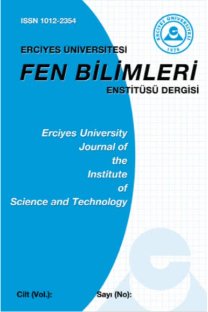The Effect of Microwave Curing on the Strength Development of Class-F Fly Ash-Based Geopolymer Mortar
Uçucu Kül, Geopolymer, Microwave curing, Strength
The Effect of Microwave Curing on the Strength Development of Class-F Fly Ash-Based Geopolymer Mortar
Fly ash, geopolymer, microwave curing, strength,
___
- References [1] N. Müller and J. Harnisch, “A Blueprint for a Climate-Friendly Cement Industry: How to Turn Around the Trend of Cement Related Emissions in the Developing World,” 2008.
- [2] D. Hardjito and B. V. Rangan, “Development and properties of low-calcium fly ash-based geopolymer concrete,” 2005.
- [3] W. K. W. Lee and J. S. J. Van Deventer, “The effect of ionic contaminants on the early-age properties of alkali-activated fly ash-based cements,” Cem. Concr. Res., 2002, doi: 10.1016/S0008-8846(01)00724-4.
- [4] P. Duxson, J. L. Provis, G. C. Lukey, and J. S. J. van Deventer, “The role of inorganic polymer technology in the development of ‘green concrete,’” Cem. Concr. Res., 2007, doi: 10.1016/j.cemconres.2007.08.018.
- [5] J. L. Provis and J. S. J. Van Deventer, Geopolymers: Structures, processing, properties and industrial applications. 2009.
- [6] L. Vickers, A. van Riessen, and W. Rickard, Fire-resistant Geopolymers: Role of Fibres and Fillers to Enhance Thermal Properties. Singapore: Springer, 2015.
- [7] A. Palomo, M. T. Blanco-Varela, M. L. Granizo, F. Puertas, T. Vazquez, and M. W. Grutzeck, “Chemical stability of cementitious materials based on metakaolin,” Cem. Concr. Res., 1999, doi: 10.1016/S0008-8846(99)00074-5.
- [8] T. Bakharev, “Durability of geopolymer materials in sodium and magnesium sulfate solutions,” Cem. Concr. Res., 2005, doi: 10.1016/j.cemconres.2004.09.002.
- [9] C. O.-P. Guillaume Haberta, “Recent update on the environmental impact of geopolymers,” RILEM Tech. Lett., vol. 1, pp. 17–23, 2016.
- [10] J. Somaratna, D. Ravikumar, and N. Neithalath, “Response of alkali activated fly ash mortars to microwave curing,” Cem. Concr. Res., vol. 40, no. 12, pp. 1688–1696, 2010, doi: 10.1016/j.cemconres.2010.08.010.
- [11] TS EN 450-1, Fly ash for concrete - Part 1: Definition, specifications and conformity criteria. Ankara: TSE, 2013.
- [12] ASTM C618, Standard Specification for Coal Fly Ash and Raw or Calcined Natural Pozzolan for Use in Concrete. merican Society for Testing and Material, 2014.
- [13] C. D. A. Erion Luga, “Strength Properties of Slag/Fly Ash Blends Activated with Sodium Metasilicate and Sodium Hydroxide+Silica Fume,” Period. Polytech. Civ. Eng., vol. 60, no. 2, pp. 223–228, 2016.
- [14] F. Khaleel, “The Effect of Microwave Curing on the Strength Development of F Class Fly Ash Based Geopolymer,” Graduate School of Natural and Applied Sciences, 2019.
- [15] TS EN 1015-11, Mortar Testing Method, Part 11. Measurement of Compressive and Flexural Tensile Strength of Mortar. Ankara: TSE, 2000.
- [16] TS EN 196-1, Methods of testing cement—part:1 determination of strength. TSE, 2016.
- [17] B. H. Mo, H. Zhu, X. M. Cui, Y. He, and S. Y. Gong, “Effect of curing temperature on geopolymerization of metakaolin-based geopolymers,” Appl. Clay Sci., 2014, doi: 10.1016/j.clay.2014.06.024.
- [18] K. Somna, C. Jaturapitakkul, P. Kajitvichyanukul, and P. Chindaprasirt, “NaOH-activated ground fly ash geopolymer cured at ambient temperature,” Fuel, vol. 90, no. 6, pp. 2118–2124, 2011, doi: 10.1016/j.fuel.2011.01.018.
- [19] G. Görhan and G. Kürklü, “The influence of the NaOH solution on the properties of the fly ash-based geopolymer mortar cured at different temperatures,” Compos. Part B Eng., vol. 58, pp. 371–377, 2014, doi: 10.1016/j.compositesb.2013.10.082.
- [20] A. M. Mustafa Al Bakria, H. Kamarudin, M. Bin Hussain, I. Khairul Nizar, Y. Zarina, and A. R. Rafiza, “The effect of curing temperature on physical and chemical properties of geopolymers,” Phys. Procedia, vol. 22, pp. 286–291, 2011, doi: 10.1016/j.phpro.2011.11.045.
- [21] C. D. Atiş, E. B. Görür, O. Karahan, C. Bilim, S. Ilkentapar, and E. Luga, “Very high strength (120 MPa) class F fly ash geopolymer mortar activated at different NaOH amount, heat curing temperature and heat curing duration,” Constr. Build. Mater., vol. 96, pp. 673–678, 2015, doi: 10.1016/j.conbuildmat.2015.08.089.
- [22] A. Graytee, J. G. Sanjayan, and A. Nazari, “Development of a high strength fly ash-based geopolymer in short time by using microwave curing,” Ceram. Int., 2018, doi: 10.1016/j.ceramint.2018.02.001.
- ISSN: 1012-2354
- Yayın Aralığı: Yılda 3 Sayı
- Başlangıç: 1985
- Yayıncı: Erciyes Üniversitesi
Toygun DAĞDEVİR, Veysel ÖZCEYHAN
Adem YURTSEVER, Erkan BAŞARAN, Deniz UÇAR
Homothetic Motions and Dual Transformations
Comparison of Gradient Boosting Decision Tree Algorithms for CPU Performance
Haithm ALSHARİ, Abdulrazak SALEH, Alper ODABAS
Ufuk YILMAZ, Ahmet TUTUŞ, Sinan SÖNMEZ
Investigation of Cappadocia Volcanic Tuffs by X-ray Diffraction (XRD) Method
Faidhalrahman KHALEEL, Cengiz ATİŞ, Uğur DURAK, Serhan İLKENTAPAR, Okan KARAHAN
